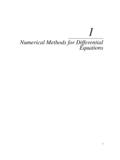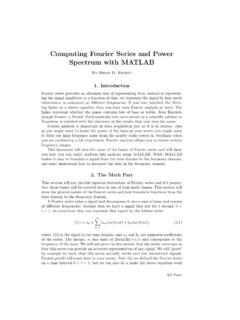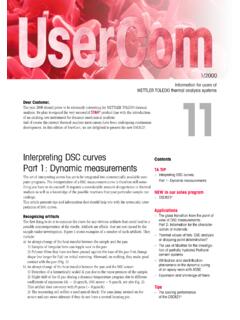Transcription of TA INSTRUMENTS DIFFERENTIAL SCANNING CALORIMETER …
1 TA INSTRUMENTS DIFFERENTIAL SCANNING CALORIMETER (DSC) Insert Nickname Here Operating Instructions TA Q100 DIFFERENTIAL SCANNING CALORIMETER 1 Table of Contents 1 INTRODUCTION Safety 2 Sample Preparation 3 2 BACKGROUND Background Information 4 Resources 6 3 INSTRUMENT OPERATION Startup 7 Sample Loading 8 Test Conditions 9 TA Q100 DIFFERENTIAL SCANNING CALORIMETER 2 Introduction he TA
2 INSTRUMENTS Q100 DIFFERENTIAL SCANNING CALORIMETER (DSC) is a powerful and versatile thermal analyzer that allows for property measurements on a broad variety of materials from -150 to 600 C. The DSC determines the temperature and heat flow associated with material transitions as a function of time and temperature. It also provides quantitative and qualitative data on endothermic (heat absorption) and exothermic (heat evolution) processes of materials during physical transitions that are caused by phase changes, melting, glass transitions, crystallization, oxidation, and other heat related changes. This information helps the scientist or engineer identify processing and end-use performance.
3 The DSC instrument works in conjunction with a controller and associated software to allow for data acquisition and analysis. Safety The following labels are displayed on the DSC instrument for your protection: Hot Stuff. The DSC is capable of heating samples to 600 C. During testing, the furnace assembly becomes noticeably hot. After testing, the furnace assembly, sample, probe, and stage may remain hot for some time. Do not touch the furnace assembly or sample stage area during heating or while the sample is cooling from an elevated temperature. 1 T TA Q100 DIFFERENTIAL SCANNING CALORIMETER 3 Cold Stuff. The DSC is capable of cooling samples to -196 C through the use of liquid nitrogen.
4 Because of its low temperature (-196 C), liquid nitrogen will cause tissue damage upon contact with your skin. When you work with liquid nitrogen, use the following precautions: Liquid nitrogen boils rapidly when exposed to room temperature. Only use liquid nitrogen in a well ventilated area to prevent displacement of oxygen in the air. Wear goggles or a face shield, cryogenic gloves, long pants, and closed-toed shoes. Transfer the liquid slowly to prevent thermal shock to the equipment. Use containers that have satisfactory low-temperature properties. Ensure that closed containers have vents to relieve pressure. Sample Decomposition. The DSC is capable of heating samples to 600 C.
5 Many materials may decompose during the heating, which can generate hazardous byproducts. WARNING: If you are using samples that may emit harmful gases, vent the gases in an appropriate manner. In general, samples should not be heated above their decomposition temperatures to prevent the release of hazardous materials or contamination of the TMA. Sample Preparation HELPFUL HINT: If possible, clean and dry your sample prior to DSC analysis. Unless you want to include experimental data from your fingerprints or other surface contaminants, wear gloves or use forceps when handling your DSC sample. dsc samples should be small enough to fit in one of the aluminum DSC pans. Powder samples or flat solid samples (less than 2 mm tall) work best, although other sample geometries are allowed.
6 Sample weight should be between and 100 mg. DSC sample preparation procedures are as follows: 1. Weigh your sample to the nearest mg with the analytical balance in Room 409. Record the weight. 2. Use forceps to place sample in the bottom half of an aluminum DSC pan. 3. Use forceps to place the aluminum pan lid on top of your sample. 4. Use forceps to load the aluminum pan and sample into the sample encapsulating press (Pope below). Align the sample pan in the encapsulating press, and press down on the handle to seal the aluminum pan. 5. Crimp an empty aluminum pan and lid. You will use the empty pan as a reference sample. TA Q100 DIFFERENTIAL SCANNING CALORIMETER 4 Background DIFFERENTIAL SCANNING calorimetry (DSC) measures the energy absorbed (endotherm) or produced (exotherm) as a function of time or temperature.
7 It is used to characterize melting, crystallization, resin curing, loss of solvents, and other processes involving an energy change. DIFFERENTIAL SCANNING calorimetry may also be applied to processes involving a change in heat capacity, such as the glass transition. Similar to thermomechanical analysis, one test can generally be used to measure most or all of these properties. In DSC analysis, the sample is placed in an aluminum pan, and the sample pan and an empty reference pan are placed on small platforms within the DSC chamber. Thermocouple sensors lie below the pans. Schematic of the interior of a DSC. Image from DSC measurements can be made in two ways: by measuring the electrical energy provided to heaters below the pans necessary to maintain the two pans at the same temperature (power compensation), or by measuring the heat flow ( DIFFERENTIAL temperature) as a function of sample temperature (heat flux).
8 The DSC ultimately outputs the DIFFERENTIAL heat flow (heat/time) between your material and the empty reference pan. Heat capacity may be determined by taking the ratio of heat flow to heating rate. Thus, TqCp = (1) where Cp is the material s heat capacity, q is the heat flow through the material over a given time, and T is the change in temperature over that same time. 2 TA Q100 DIFFERENTIAL SCANNING CALORIMETER 5 A schematic of a DSC thermogram is shown in the following figure: Notice that this graph labels four critical points: the glass transition temperature (Tg), the crystallization temperature (Tc), the melting temperature (Tm), and the curing temperature.
9 The glass transition temperature (Tg) is also an important characteristic of noncrystalline and semicrystalline materials, but Tg is a particularly significant property of many common polymers. At a temperature below Tg, amorphous and semicrystalline polymers tend to be hard and brittle because the polymer chains are locked in a tangled, coiled position. Above Tg, the polymeric chains are able to more easily rotate and slip past each other, and the polymer becomes softer and more ductile. Generally the glass transition point depends on the processing of the material, as well as that material s natural characteristics such as structure, bonding, and molecular weight. Since it takes energy to break these bonds, the glass transition appears on a DSC curve as an endothermic process.
10 In DSC, the Tg can be found by a permanent decrease in baseline heat flow, and Tg is usually taken as the inflection point in the curve. The crystallization temperature (Tc) is another important transition that occurs in some polymeric materials. At the crystallization temperature, the polymer loses its random chain arrangement, intermolecular bonds form, and the polymer molecules become more ordered. Formation of bonds during crystallization is an exothermic process, so an increase in heat flow (a peak on the DSC curve) accompanies the crystallization process. Generally, the Tc is found by finding the onset point of the crystallization curve. Note that many amorphous polymers never undergo crystallization.



